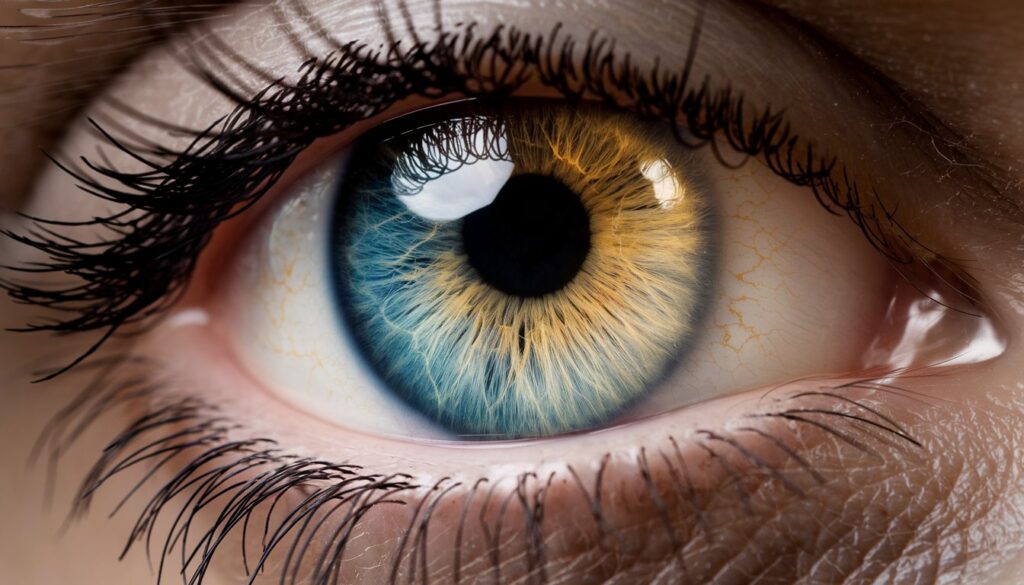Central Heterochromia vs. Hazel Eyes
Ihr Leitfaden, Informationen und Tipps
Central Heterochromia vs. Hazel Eyes: Unveiling the Mysteries of Eye Color
The human eye is a window to the soul, and its color adds to the uniqueness of every individual. Two eye color variations that often cause confusion are central heterochromia and hazel eyes. While they may appear similar at first glance, understanding their differences reveals fascinating insights into genetics and pigmentation.
In this article, we’ll delve into what sets central heterochromia apart from hazel eyes, explore their causes, and provide tips on how to highlight these unique eye features with makeup, fashion, and the perfect eyewear from ROLF Spectacles.
Key Takeaways of Central Heterochromia vs. Hazel Eyes
| Key Point | Summary |
|---|
| Definition of Central Heterochromia | A condition where the iris has two distinct colors, with a different color around the pupil compared to the rest of the iris. |
| Definition of Hazel Eyes | An eye color characterized by a combination of brown and green, often with golden or amber flecks, resulting from light scattering. |
| Main Differences | Central heterochromia involves two colors in one iris due to pigmentation differences, while hazel eyes have a uniform mixture of colors. |
| Causes | Central heterochromia is caused by uneven melanin distribution, often genetic; hazel eyes result from moderate melanin and Rayleigh scattering. |
| Enhancing Eye Color | Tips on makeup, fashion, and eyewear choices to accentuate both central heterochromia and hazel eyes. |
| ROLF Spectacles Eyewear | Eyewear options like Bean Glasses, Wooden Glasses, and Horn Glasses to highlight unique eye colors. |
| Eye Care | Importance of maintaining eye health through proper care and regular check-ups. |
Understanding Central Heterochromia
Definition and Characteristics
Central heterochromia is a condition where the iris displays two distinct colors. Specifically, the area around the pupil (the central part of the iris) is a different color than the outer part of the iris. This results in a striking, multi-colored appearance, often described as a “cat-eye” look.
- Inner Ring Color: The color surrounding the pupil is typically golden, amber, or brown.
- Outer Ring Color: The rest of the iris may be blue, green, gray, or another color.
- Pattern: The transition between the two colors is usually sharp, creating a noticeable contrast.
Causes of Central Heterochromia
- Genetic Factors: Central heterochromia is usually hereditary and results from variations in melanin distribution in the iris.
- Melanin Distribution: Uneven distribution of melanin pigment causes the iris to display different colors.
- Not Indicative of Disease: In most cases, central heterochromia is benign and does not affect vision or eye health.
Understanding Hazel Eyes
Definition and Characteristics
Hazel eyes are characterized by a blend of colors, primarily brown and green, distributed uniformly throughout the iris. They often appear to change color depending on lighting and surroundings due to the way light scatters within the iris.
- Color Composition: A combination of brown and green, sometimes with gold or amber flecks.
- Appearance: The colors are mixed together rather than in distinct rings.
- Light Sensitivity: Hazel eyes may appear more green or brown under different lighting conditions.
Causes of Hazel Eyes
- Moderate Melanin Levels: Hazel eyes have more melanin than green eyes but less than brown eyes.
- Rayleigh Scattering: Light scattering off the iris stroma contributes to the greenish hue.
- Genetics: Multiple genes influence the amount and distribution of melanin, resulting in hazel eyes.
Back
Greyblue
Ravi
Sapphire Blue
“Illuminate your hazel green eyes with personalized style and let them captivate the world.”
Central Heterochromia vs. Hazel Eyes: Key Differences
1. Color Distribution
- Central Heterochromia: Two distinct colors with a sharp boundary between the inner and outer iris.
- Hazel Eyes: A uniform mixture of colors throughout the iris without distinct boundaries.
2. Appearance
- Central Heterochromia: Noticeable dual-colored iris with a contrasting inner ring.
- Hazel Eyes: Blended colors that may shift in appearance under different lighting.
3. Causes
- Central Heterochromia: Caused by uneven melanin distribution, often genetic.
- Hazel Eyes: Result from moderate melanin levels and light scattering effects.
4. Prevalence
- Central Heterochromia: Relatively rare condition.
- Hazel Eyes: More common, especially in people of European descent.
5. Health Implications
- Central Heterochromia: Generally harmless; rarely associated with medical conditions.
- Hazel Eyes: Normal eye color with no health concerns.
The Influence of Lighting and Environment on Eye Color Appearance
The appearance of eye color can be surprisingly dynamic, especially for individuals with central heterochromia or hazel eyes. Lighting conditions and environmental factors can significantly impact how these eye colors are perceived, sometimes making them appear to change color. Understanding these effects can help you appreciate the unique beauty of your eyes and find ways to accentuate them.
1. Lighting Conditions
Natural Sunlight vs. Artificial Light
Natural Sunlight: In bright sunlight, the eyes receive full-spectrum light, which can enhance the lighter pigments in the iris. For hazel eyes, this may bring out the golden or green tones, making the eyes appear lighter or more vibrant. Central heterochromia may become more pronounced, with the contrasting colors in the iris appearing more distinct.
Artificial Lighting: Indoor lighting, such as fluorescent or LED lights, often lacks the full spectrum of natural sunlight. This can cause the eyes to appear duller or emphasize different pigments. Warm lighting may enhance golden or brown tones, while cool lighting can bring out blues and greens.
Time of Day
Golden Hour: The soft, warm light during sunrise or sunset can add a golden hue to the eyes, highlighting amber or golden flecks in hazel eyes or the inner ring of central heterochromia.
Overcast Conditions: Diffused lighting on cloudy days reduces shadows and can soften the appearance of eye color, making it appear more uniform.
2. Surrounding Colors
Clothing and Accessories
Color Reflection: Wearing clothing or accessories in certain colors can reflect onto the eyes, enhancing specific hues. For example, wearing a green shirt can make the green tones in hazel eyes more prominent.
Jewelry and Makeup: Metallic jewelry in gold or silver can influence the perceived warmth or coolness of eye color. Eyeshadows and eyeliners in complementary colors can accentuate particular pigments in the iris.
Background and Environment
Color Contrast: The colors in your surroundings can create a contrast that affects how your eye color is perceived. A neutral background may make your eyes stand out more than a brightly colored one.
Reflection from Surfaces: Light reflecting off surfaces like water, mirrors, or light-colored walls can cast subtle hues onto your face and eyes, altering their appearance.
3. Pupil Size and Emotional State
Pupil Dilation
Impact on Iris Visibility: The size of your pupils can affect how much of the iris is visible. In low light, pupils dilate, reducing the visible area of the iris and potentially changing the perception of eye color.
Emotional Responses: Emotions like excitement or attraction can cause pupils to dilate, subtly influencing eye appearance.
4. Photography and Filters
Camera Settings
Exposure and White Balance: The camera’s exposure settings and white balance can alter how eye color appears in photos. Adjusting these settings can enhance or diminish certain eye colors.
Flash Photography: Using a flash can brighten the eyes but may also wash out subtle color variations.
Photo Filters and Editing
Enhancement Tools: Photo editing software can adjust saturation, contrast, and brightness, affecting eye color in images.
Filters: Social media filters may alter eye color intentionally or as a side effect of other adjustments.
5. Optical Effects
Rayleigh Scattering
- Light Scattering: The scattering of light in the iris stroma can affect eye color appearance, especially in lighter eyes. This optical phenomenon is influenced by the wavelength of incoming light, which varies under different lighting conditions.
Practical Tips to Utilize Lighting and Environment
Choose Optimal Lighting: For photographs or events where you want your eye color to stand out, position yourself in lighting that enhances your desired eye tones. Natural sunlight is often the most flattering.
Select Complementary Colors: Wear clothing and accessories that reflect or complement your eye color to make it more prominent.
Be Mindful of Surroundings: When possible, choose environments that enhance rather than detract from your eye color.
Enhancing Your Unique Eye Color
Whether you have central heterochromia or hazel eyes, there are various ways to accentuate your eye color and make it stand out.
Makeup Tips
For Central Heterochromia
- Emphasize Contrast: Use eyeshadows that complement both colors in your iris.
- Inner Ring: If the inner ring is golden, use gold or bronze shades.
- Outer Iris: Match eyeshadow to the outer iris color, such as blues or greens.
- Eyeliner Techniques: Apply a thin line close to the lash line to define the eyes without overshadowing the iris colors.
- Mascara Choices: Use black or brown mascara to frame the eyes and draw attention to the iris.
For Hazel Eyes
- Enhance Green Tones: Use purple or plum eyeshadows to make the green in hazel eyes pop.
- Highlight Golden Flecks: Gold or bronze eyeshadows can bring out amber tones.
- Blend Well: Create seamless transitions to mimic the blended colors of hazel eyes.
Fashion and Accessories
Clothing Colors
- Central Heterochromia: Wear colors that match or complement both iris colors.
- Dual-Tone Outfits: Incorporate both colors into your attire.
- Hazel Eyes: Earth tones, greens, and warm browns enhance hazel eyes.
Jewelry
- Gemstones: Wear jewelry with stones that match your eye colors, such as emeralds, amber, or sapphires.
- Metals: Gold jewelry complements warm tones; silver or platinum suits cooler hues.
Hair Colors
- Central Heterochromia: Choose hair colors that don’t overpower your eyes. Subtle highlights can draw attention to your eye color.
- Hazel Eyes: Warm hair colors like caramel, auburn, or chestnut enhance hazel eyes.
Eyewear from ROLF Spectacles
Frame Colors and Styles
- Neutral Frames: Clear or light-colored frames allow your eye color to stand out.
- Complementary Colors: Choose frames that match or contrast with your iris colors.
- Minimalist Designs: Slim frames keep the focus on your eyes.
ROLF Spectacles Collections
Bean Glasses
- Design: Organic shapes that complement facial features.
- Materials: Sustainable materials like wood or plant-based substances.
- Benefit: Enhances natural eye colors without distraction.
Wooden Glasses
- Unique Texture: Natural wood grain adds character.
- Warm Tones: Complements warm hues in your eyes.
- Sustainability: Eco-friendly choice.
Horn Glasses
- Luxurious Material: Ethically sourced horn offers unique patterns.
- Color Variations: Natural color variations enhance eye color.
- Durability: Strong and hypoallergenic.
Visit Us
Explore our collections at ROLF Spectacles and find the perfect eyewear to accentuate your central heterochromia or hazel eyes.
Eye Care and Health
Frame Colors and Styles
- Neutral Frames: Clear or light-colored frames allow your eye color to stand out.
- Complementary Colors: Choose frames that match or contrast with your iris colors.a
Maintaining healthy eyes is essential to keep your unique eye color—whether it’s central heterochromia or hazel—vibrant and clear. Good eye health not only enhances the appearance of your eyes but also contributes to overall well-being. Here are some tips to help you take care of your eyes:
1. Regular Eye Examinations
Schedule Routine Check-Ups: Visit an eye care professional at least once every two years, or as recommended, to monitor your eye health and vision.
Early Detection: Regular exams can identify potential issues like glaucoma, cataracts, or macular degeneration early on, improving the chances of effective treatment.
2. Protect Your Eyes from UV Light
Wear Sunglasses: Use sunglasses that block 100% of UVA and UVB rays when outdoors to shield your eyes from harmful ultraviolet radiation.
Use Protective Eyewear: If you’re engaged in activities like sports or DIY projects, wear appropriate safety glasses to prevent injuries.
3. Maintain a Healthy Diet
Nutrient-Rich Foods: Incorporate foods high in omega-3 fatty acids, vitamins A, C, and E, and zinc. Examples include leafy greens, carrots, citrus fruits, nuts, and fish like salmon.
Stay Hydrated: Drinking plenty of water helps maintain optimal eye moisture and reduces dryness.
4. Practice Good Screen Habits
Follow the 20-20-20 Rule: Every 20 minutes, look at something 20 feet away for at least 20 seconds to reduce eye strain from screens.
Adjust Screen Settings: Ensure your device’s brightness and contrast are comfortable, and consider using blue light filters.
5. Avoid Smoking
- Quit Smoking: Smoking increases the risk of eye diseases such as cataracts and age-related macular degeneration. Quitting can significantly benefit your eye health.
6. Get Adequate Sleep
- Rest Your Eyes: Aim for 7–9 hours of sleep per night to help your eyes recover from daily strain.
7. Practice Good Hygiene
Wash Hands Regularly: Clean hands reduce the risk of transferring bacteria to your eyes.
Proper Contact Lens Care: If you wear contacts, follow the cleaning and replacement schedule provided by your eye care professional.
8. Manage Allergies
Reduce Exposure: Limit contact with allergens like pollen, dust, and pet dander that can irritate your eyes.
Use Artificial Tears: Over-the-counter lubricating eye drops can alleviate dryness and discomfort.
9. Stay Active
- Regular Exercise: Physical activity improves blood circulation, which can benefit your eyes by increasing oxygen supply and removing toxins.
10. Be Mindful with Eye Makeup
Choose Hypoallergenic Products: Opt for makeup that is less likely to cause irritation.
Remove Makeup Thoroughly: Cleanse your face before bed to prevent clogged pores and potential infections.
Embrace Your Unique Eye Color
Taking care of your eyes ensures that your distinctive eye color remains a captivating feature. By incorporating these eye care practices into your daily routine, you can maintain healthy eyes that continue to shine brightly.
- Minimalist Designs: Slim frames keep the focus on your eyes.
ROLF Spectacles Collections
Bean Glasses
- Design: Organic shapes that complement facial features.
- Materials: Sustainable materials like wood or plant-based substances.
- Benefit: Enhances natural eye colors without distraction.
Wooden Glasses
- Unique Texture: Natural wood grain adds character.
- Warm Tones: Complements warm hues in your eyes.
- Sustainability: Eco-friendly choice.
Horn Glasses
- Luxurious Material: Ethically sourced horn offers unique patterns.
- Color Variations: Natural color variations enhance eye color.
- Durability: Strong and hypoallergenic.
Visit Us
Explore our collections at ROLF Spectacles and find the perfect eyewear to accentuate your central heterochromia or hazel eyes.



